Bosmere and Claydon, Suffolk
Up to 1834
A local Act of 1765 established the Bosmere and Claydon Hundreds Incorporation of 35 parishes. In the following year the Incorporation built a "House of Industry" on a 20-acre site at Barham. It was an H-shaped red brick building of two storeys with attics. Construction of the building cost £10,000 and it could accommodate 400 inmates.
According to a parliamentary report of 1776, the work performed by the workhouse inmates included spinning wool, sewing, knitting, and "making such things as are wanted in the family". The able men were employed in "domestic affairs". Income from the labour of the poor in 1774 was £250.6s.
The workhouse officers were the governor (£40 per annum), chaplain (£35), treasurer (£10.10s), three surgeons (£42 each), schoolmaster (£8.8s), clerk (£10), and baker (£16).
A parliamentary report of 1777 recorded parish workhouses in operation at Debenham (for up to 40 inmates), Framsden (40) and Pettaugh (15).
Debenham's workhouse formed a row lying at right-angles to the street opposite the west end of the church. In the mid-nineteenth century, local shopkeeper Samuel Dove described it as:
After 1834
The Bosmere and Claydon Poor Law Union formally came into being on 8th September 1835. Its operation was overseen by an elected Board of Guardians, 40 in number, representing its 38 constituent parishes as listed below (figures in brackets indicate numbers of Guardians if more than one):
County of Suffolk:
Akenham, Ashbocking, Ashfield with Thorpe, Badley, Barham, Barking Parish including Needham Market (2), Battisford, Bailham or Baylham, Great Blakenham, Little Blakenham, Bramford, Great Bricett, Claydon, Coddenham, Creeting All Saints, Creeting St Mary, Creeting St Olave, Crowfield, Darmsden, Debenham (2), Flowton, Framsden, Gosbeck, Helmingham, Hemingstone, Henley, Mickfield, Nettlestead, Offton, Pettaugh, Ringshall, Somersham, Earl Stonham, Little Stonham, Stonham Aspall, Swilland, Willisham, Winston.
Later Addition: Needham Market (from 1907), Whitton (from 1895).
The population falling within the Union at the 1831 census had been 15,957 with parishes ranging in size from from Creeting St Olave (population 44) to Barking and Needham Market (1,884). The average annual poor-rate expenditure for the period 1833-35 had been £14,306 or 17s.11d. per head of the population.
The existing Incorporation workhouse was taken over by the new Bosmere and Claydon Poor Law Union in 1835 when it was adapted for use under the 1834 Act. The Poor Law Commissioners authorised the sum of £1,000 to be spent on the work.
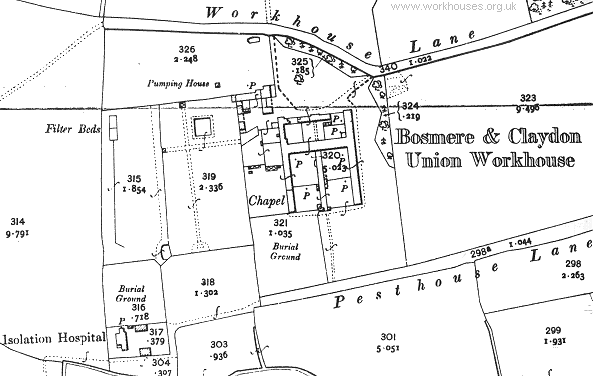
Bosmere and Claydon workhouse site, 1904.
Wards for the sick were located on the first floor of each wing, with two rooms for women and three for men. There were also three lying-in wards at the front of the building. The wards were large and wide but only had windows on one side. A chapel was located at the south of the west wing. An isolation hospital stood at some distance from the main workhouse at the end of Pesthouse Lane. The workhouse location and layout are shown on the 1904 map below.
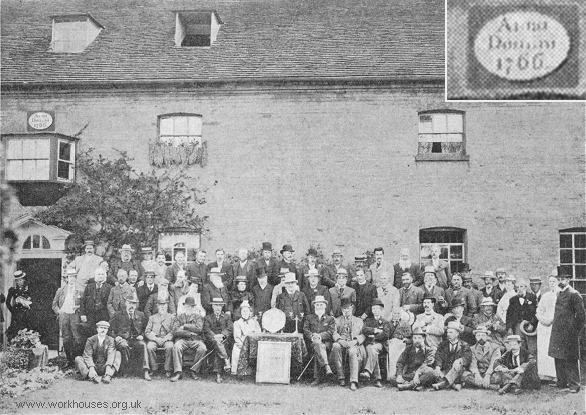
Presentation ceremony at workhouse for Bosmere and Claydon Chairman of Guardians, TW Burch.
On 7th January, 1850, a riot took place at the workhouse. Around fifty able-bodied inmates, who had been admitted a few days earlier, got out of their ward and demanded more food. After the governor told them that he had no power to alter their diet, they tore up the seats and part of the flooring in their day rooms. With the arrival of a policemen, the men remained quiet during the night but their rioting was resumed the next morning and the governor was struck and injured. Eventually a detachment of Lancers was sent from Ipswich but, by the time they arrived, the riot had been quelled by the police and six of the ringleaders put into prison.
Similar disturbances occurred just over a year later when there were about 490 inmates in the workhouse, 120 of whom were able-bodied men. Amongst the latter some dissatisfaction had been expressed that the quantity of food allowed them was so little. However, excepting a good deal of grumbling, all things went on tolerably well until the evening of 9th February. The inmates finished their supper at a little before seven, and the governor having said grace, one of the men gave a signal, and instantly about forty of them commenced a furious attack on a wooden partition that divided them from the females' ward. The governor, schoolmaster, and three police-officers attempted to restore order but they were pelted with objects, one of the constables having his eye seriously damaged by a stone. The porter was struck to the ground and brutally kicked, and the superintendent of labour had, after a vain resistance, to make his escape. At about seven o'clock, the inmates had taken charge of the establishment and began demolishing the building. Glass, window-frames, benches, floors, tables, chairs, clocks etc. were ruthlessly smashed. The provision stores were ransacked, the cooked meat was eaten, and the raw meat was quickly cooked and devoured. The wines speedily disappeared, and the stores of beer were either drunk or smashed. Emboldened by drink, the inmates wrenched the fastenings from the doors, stripped the roofs of tiles, tore up the brick stone floorings, and made a large breach in a substantial brick wall. Having provided themselves with a good stock of missiles, they showered them over the walls upon any who might happen to be near. At about nine o'clock the Rev. F. Steward, a Magistrate, rode off to Ipswich for a detach ment of the military. A troop was soon mustered, and by a little past ten o'clock had galloped to the scene of action. Captain Peel was in command, but he would not permit his men to dismount — it being contrary to regulations — the consequence was that the force at that time was of no use. About five policemen were in attendance, and it was nearly twelve o'clock before another body arrived; it consisted of eight men, under Mr. Jukes. At this time the inmates had had complete control over the premises for five hours, and beside effecting the damage described, they had burnt the governor's account books. The whole police force was soon mustered, and by the aid of a battering-ram the door was forced, when the constables, with drawn cutlasses, supported by two or three others, rushed upon the rioters, who after discharging one or two sharp volleys of bricks, stones, and glass, retreated in all directions. There was, however, a hot pursuit and for ten minutes the scene was an exciting one. Every place was scoured, and the prisoners, when captured, were hurried out of the building and placed under the guard of the soldiery. Many of them were much intoxicated, and one strong noisy fellow after he had been turned out exclaimed, pointing to the building, "That is hell, and there they lead us to hell. God Almighty is on my side, and he'll protect me!" The prisoners were ultimately placed in the strong room. The military returned to Ipswich at three o'clock. The next morning, many of the inmates insisted their sole cause of complaint was want of sufficient food. One of them said, "Hunger is a sharp thorn, and it is enough to make us do what we would not." A total of thirty-eight of the protestors were taken into custody. Eight of the men identified by the governor as having begun the riot were committed for trial at the next Ipswich Quarter Sessions, on the charge of destroying the property of the guardians, and of obstructing the police in the execution of their duty. They were immediately afterwards handcuffed and forwarded in an omnibus to Ipswich. On their passage through the streets of the town they shouted most lustily, and seemed exceedingly merry.
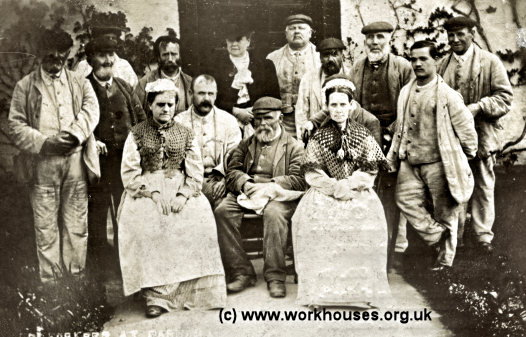
Barham inmates, early 1900s.
© Peter Higginbotham.
During the First World War, the workhouse premises were occupied by troops or prisoners of war. It then became a residential re-training centre for unemployed ex-servicemen, some receiving 'handyman' training, the rest being prepared for work on farms overseas. In 1929, it became one of a new type of Transfer Instructional Centres being set up by the Ministry of Labour for 'reconditioning' unemployed men who were said to have gone 'soft' by being out of work. Under the threat of losing their unemployment benefit, men were sent to the Centres and given hard physical work.
During the Second World War, the site was used to house Italian prisoners of war. The building was finally demolished in 1963.
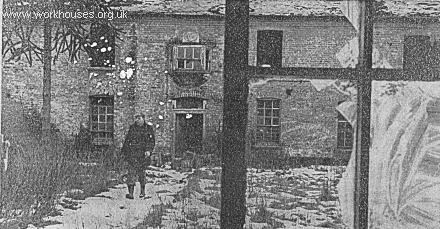
Bosmere and Claydon workhouse shortly before its demolition in 1963.
Barham is one of the workhouses with a claim to have been the basis of Charles Dickens' story Oliver Twist. Dickens is said to have been shown around the workhouse on a visit to Suffolk and to have seen a record book containing the details of a ten-year-old boy's apprenticeship.
Needham Market Children's Home
In the 1920s, the union operated a children's home in a house called 'Hurstlea' at 131 High Street in Needham Market. In 1924, the home could accommodate 87 children, with H. Martin as Superintendent. By 1929, the home's capacity had been reduced to 50 and W.J. Dove was now in charge.
The building is now used as council offices.
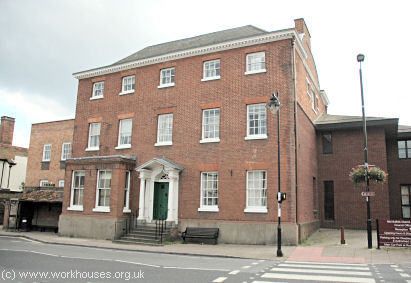
Former Needham Market children's home, 2006.
© Peter Higginbotham.
Staff
Inmates
Records
Note: many repositories impose a closure period of up to 100 years for records identifying individuals. Before travelling a long distance, always check that the records you want to consult will be available.
- Suffolk Archives, The Hold, 131 Fore Street, Ipswich, Suffolk IP4 1LR. Holdings include: Guardians' minute books (1821-1930); Admissions and discharges (1766-82); etc.
Bibliography
- Abstract of the Returns from the Governors, Directors etc. of the Several Houses of Industry, and Workhouses, Specially Established for the Relief and Employment of the Poor (1776).
Links
- None.
Unless otherwise indicated, this page () is copyright Peter Higginbotham. Contents may not be reproduced without permission.


